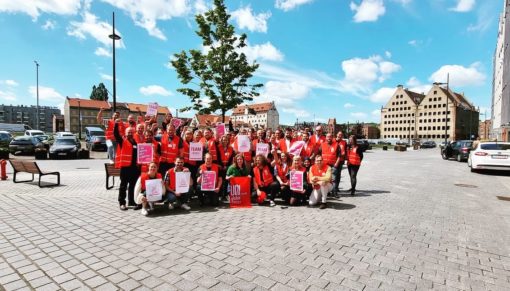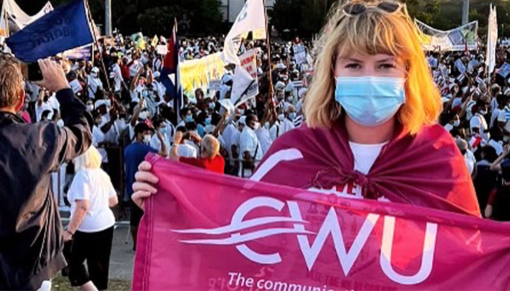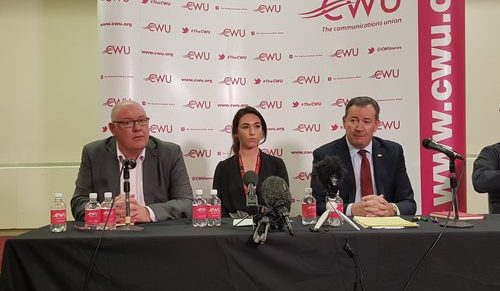Rachel Reeves, Maternity Leave and CWUYouth
October 7 2015The utterly appallingand reactionaryhowls thatgreeted Rachel Reeve’s maternityleave plans (http://www.express.co.uk/comment/columnists/virginia-blackburn/560407/Virginia-Blackburn-on-Rachel-Reeves-Dakota-Johnson-gerbils) remind us that although we have come a long way,there is still just as far to go on when it comes to recognising that (1) women have babies and (2) women can have babies and hold downjobs too.
Of course, thepoint some commentators and otherswas makingwasit wasn’t the“baby”bit of thisthatis a problem – but the maternity leave.
It is an unavoidable issue that for the human race to survive, we need to reproduce. If we reproduce, our offspring and their parents need to be looked after. The quality of the “looking after” stuff makes a big difference to other things – life chances, health, wellbeing,etc.
But – and let’s not fudge this issue -having staff absent from work can be disruptive. But just because it can be doesn’t mean it has to be.
Here in the Communication Workers” Union, we have been trying to address these issues. Our national youth committee has now had numerous young women members who have taken maternity leave during their term of office. Committee members are all lay representatives – they are not our employees. So while the companies that employ them are obliged under he law and their collective agreements with us to release them from duty, what about their union work?
There are all sorts of issues here; if you are on leave, then surely that’s it – you are away from work full stop. How can the demands of occupying a national representative position be compatible with caring for an entirely dependent very young child?If you are absorbed in your new baby’s welfare, how can you concentrate on union work?
But on the other hand,if we happened to have a number ofwomen away on maternity leave at the same time,thatwould denudeeffective membership of the committee.The classic “impact on small organisations” scenario.
Let’s try and nail a few of these issues.
Setting aside the trend towards parental (or adoptive) leave, as well as maternity leave, we have shown that it is possible to turn a pessimist’s problem into to an optimistic solution.
Funnily enough, we knew thatthere would be a need to manage a maternity leave vacancy on the committee some time in advance – usually around 4-5 months. So this should not be something that catches peole by surprise.
Even in democratic organisations,when decisions can sometimes take longer to make,there is timeto take soundingsand secure agreement – in this caseforsomeone to be co-opted to thecommittee to cover thematernity leave.
Our youth committee is comprised of regionally and occupationally based representatives.So we agreed to co-opt someone fromthe same geography and ideally the same industrial sector as the person on leave. But above all we were clear that the co-optee had to be a woman to preserve the gender balance of the committee.
But we did not want to disadvantage the person on maternity leave – nor lose her input into decisions.So the committee agreed tomaintain contact with her, but recognisedthatshe may not alwayswant totocontribute tovirtualdebatesor email exchanges.
We adopted a similar approachwith attendance at committee meetings and events.If our colleague on maternity leave is able to attend, that would be great.Would we expect her to attend? No, not necessarily.The approach was designed to keep women on maternity leave involved, without making any presumptions about what that involvement would mean in practical terms.
And of course, we make sure that appropriate practical support is available, in terms of arrangements for partners to travel with mothers.
On some occasions, the member on maternity leave and their maternity leave cover would attend the same meeting.But any potential problems about who gets to use the vote associated with one place on the committee that they are both associated with, is overcome by discussion before -hand.
On one occasion, a colleague insisted on standing down from the committee because of her baby being due. The committee promptly co-opted her for the duration of her maternity leave.
All these things are not charitable acts. That would be arguably patronising in the extreme.As a union, we need to do more to attract and retain young activists, and young women activists. Women are after all over 50% of the UK workforce.Without the stepsoutlined above,we would have losttheexpertise, insight,involvement andsupportof young women in the very leadership positionsneeded topromotebetter ways of working.
So we should loudly proclaim our support for Rachel Reeves for identifying as someone who will demonstrate that the sort of work-life balance that promotes a better society is both desirable and achievable. Ifshecan do it inthatset of circumstances, the doom-laden nay-sayers will be forced to think again.
This is an extended version of an article thatwas published on Labour Listhttp://labourlist.org/2015/02/why-we-should-loudly-support-rachel-reeves-right-to-maternity-leave/

























































